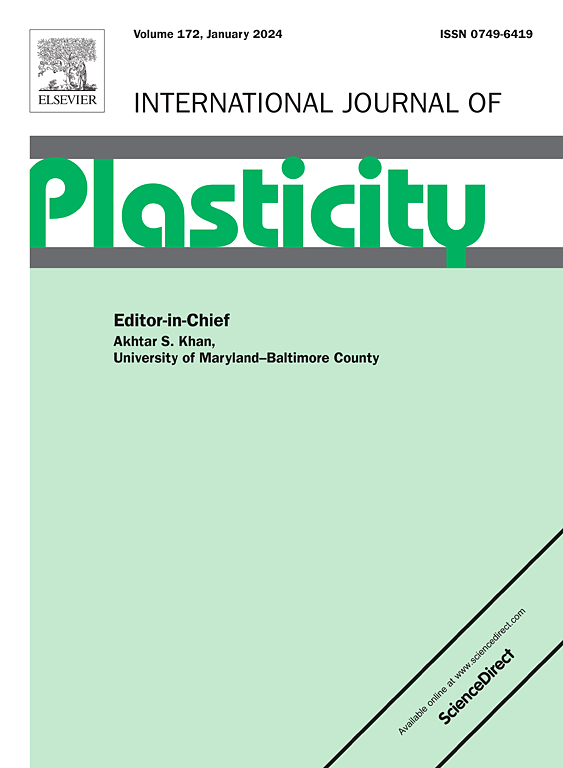Tensile behavior of additively manufactured Inconel 718 and stainless steel 316L with compositionally graded joints
IF 12.8
1区 材料科学
Q1 ENGINEERING, MECHANICAL
引用次数: 0
Abstract
The microstructure and tensile behavior of laser powder bed fusion (LPBF) processed 316L austenitic stainless steel (316L) and Inconel 718 Ni-based superalloy (IN718) coupons with compositionally graded joints (CGJ), spanning lengths of 0, 10 and 20 mm, in the as built and heat-treated conditions, are investigated. In the as built condition, the microstructure of pure 316L and IN718 ligaments consist of micron-sized sub-grains present within 〈001〉 textured columnar grains, whereas CGJs contain a mixture of randomly textured columnar and equiaxed grains. Heat treatment, involving solutionizing above 1040 °C with subsequent ageing at 720 and 620 °C, leads to the recrystallization of portions with > 85 wt. % IN718 of the CGJ coupons. Higher composition gradient span, in both the as built and heat-treated states, improves the yield and tensile strengths of the specimens, but compromises ductility. Simulations indicate that CGJs with shallower composition gradients have lower fluctuations in the stress triaxiality, von mises equivalent stress, and the maximum shear stress compared to those with sharper gradients. These mechanical property variations and the deformation characteristics of the CGJ specimens are analyzed in detail by considering the varying degrees of plastic constraint on the 100 wt. % 316L and the degree of interactions between strain-generated dislocations and geometrically necessary dislocations. Finally, the effectiveness of CGJ in enhancing the tensile properties of the 316L/IN718 joints and the geometrical considerations for designing such joints for different alloy combinations is discussed.


增材制造Inconel 718和不锈钢316L复合梯度接头的拉伸性能
研究了激光粉末床熔合(LPBF)加工316L奥氏体不锈钢(316L)和Inconel 718镍基高温合金(IN718)在预制和热处理条件下的组织和拉伸行为,并对其组成渐变接头(CGJ)的长度分别为0、10和20 mm。在建立的条件下,纯316L和IN718韧带的显微组织由微米级的亚晶粒组成,这些亚晶粒存在于<;001>;而cgj则包含随机织构的柱状和等轴晶粒的混合物。热处理,包括1040℃以上固溶,随后在720℃和620℃时效,导致含有>的部分再结晶;85%的CGJ券。较高的成分梯度跨度,无论是在建成和热处理状态,提高屈服和抗拉强度的试样,但妥协延性。拉压不对称性随应变和CGJ跨度的增大而逐渐增大。模拟结果表明,相对于梯度较陡的复合材料,梯度较浅的复合材料在应力三轴性、von mises等效应力和最大剪切应力方面的波动较小。考虑到100wt .% 316L的塑性约束程度的不同,以及应变产生的位错与几何必要位错之间的相互作用程度,详细分析了CGJ试样的力学性能变化和变形特征。最后,讨论了CGJ提高316L/IN718接头拉伸性能的有效性,以及设计不同合金组合的接头时应考虑的几何因素。
本文章由计算机程序翻译,如有差异,请以英文原文为准。
求助全文
约1分钟内获得全文
求助全文
来源期刊

International Journal of Plasticity
工程技术-材料科学:综合
CiteScore
15.30
自引率
26.50%
发文量
256
审稿时长
46 days
期刊介绍:
International Journal of Plasticity aims to present original research encompassing all facets of plastic deformation, damage, and fracture behavior in both isotropic and anisotropic solids. This includes exploring the thermodynamics of plasticity and fracture, continuum theory, and macroscopic as well as microscopic phenomena.
Topics of interest span the plastic behavior of single crystals and polycrystalline metals, ceramics, rocks, soils, composites, nanocrystalline and microelectronics materials, shape memory alloys, ferroelectric ceramics, thin films, and polymers. Additionally, the journal covers plasticity aspects of failure and fracture mechanics. Contributions involving significant experimental, numerical, or theoretical advancements that enhance the understanding of the plastic behavior of solids are particularly valued. Papers addressing the modeling of finite nonlinear elastic deformation, bearing similarities to the modeling of plastic deformation, are also welcomed.
 求助内容:
求助内容: 应助结果提醒方式:
应助结果提醒方式:


